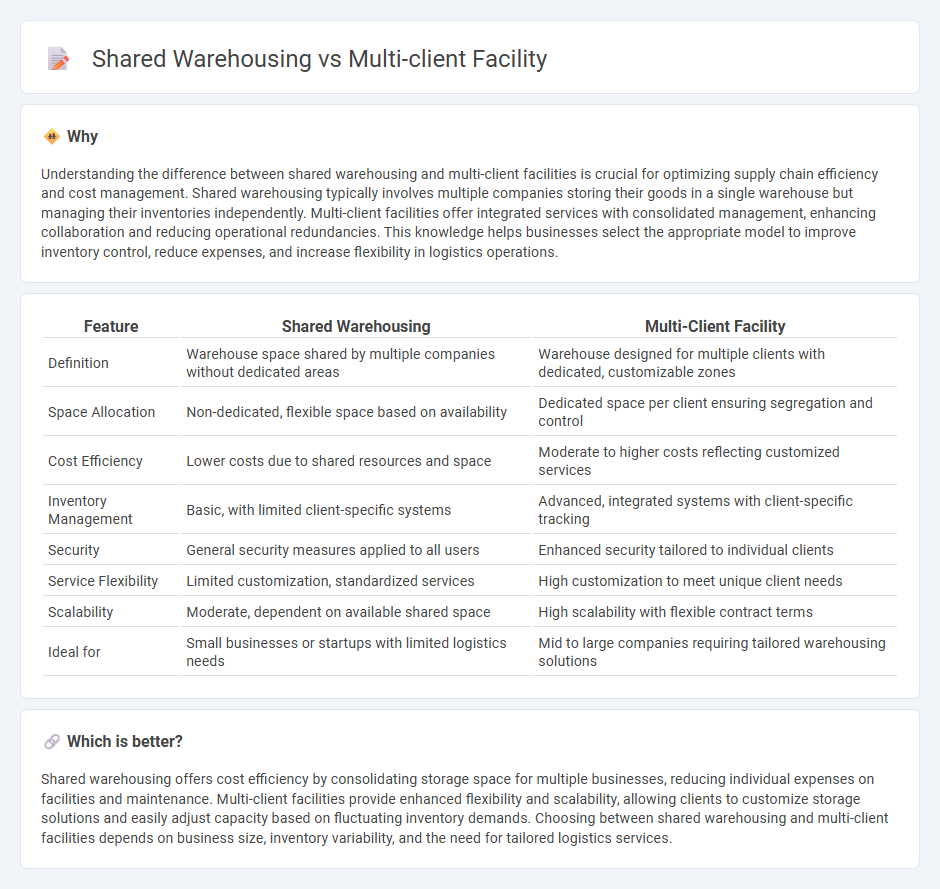
Shared warehousing offers businesses the advantage of reduced costs by pooling storage space and resources, making it ideal for companies with fluctuating inventory levels. Multi-client facilities provide tailored services and improved operational efficiency by servicing multiple tenants under one roof, each benefiting from customized layouts and technology integration. Explore more to understand how these solutions can optimize your supply chain management.
Why it is important
Understanding the difference between shared warehousing and multi-client facilities is crucial for optimizing supply chain efficiency and cost management. Shared warehousing typically involves multiple companies storing their goods in a single warehouse but managing their inventories independently. Multi-client facilities offer integrated services with consolidated management, enhancing collaboration and reducing operational redundancies. This knowledge helps businesses select the appropriate model to improve inventory control, reduce expenses, and increase flexibility in logistics operations.
Comparison Table
| Feature | Shared Warehousing | Multi-Client Facility |
|---|---|---|
| Definition | Warehouse space shared by multiple companies without dedicated areas | Warehouse designed for multiple clients with dedicated, customizable zones |
| Space Allocation | Non-dedicated, flexible space based on availability | Dedicated space per client ensuring segregation and control |
| Cost Efficiency | Lower costs due to shared resources and space | Moderate to higher costs reflecting customized services |
| Inventory Management | Basic, with limited client-specific systems | Advanced, integrated systems with client-specific tracking |
| Security | General security measures applied to all users | Enhanced security tailored to individual clients |
| Service Flexibility | Limited customization, standardized services | High customization to meet unique client needs |
| Scalability | Moderate, dependent on available shared space | High scalability with flexible contract terms |
| Ideal for | Small businesses or startups with limited logistics needs | Mid to large companies requiring tailored warehousing solutions |
Which is better?
Shared warehousing offers cost efficiency by consolidating storage space for multiple businesses, reducing individual expenses on facilities and maintenance. Multi-client facilities provide enhanced flexibility and scalability, allowing clients to customize storage solutions and easily adjust capacity based on fluctuating inventory demands. Choosing between shared warehousing and multi-client facilities depends on business size, inventory variability, and the need for tailored logistics services.
Connection
Shared warehousing and multi-client facilities are interconnected as both optimize space utilization by accommodating multiple businesses within a single distribution center. These logistics solutions reduce operational costs through shared infrastructure, labor, and technology while enhancing inventory management efficiency. Leveraging economies of scale, they enable flexible, scalable storage and streamlined supply chain operations for diverse clients.
Key Terms
Cost Allocation
Multi-client facilities allow cost allocation based on individual client usage, offering transparent billing that reflects actual resource consumption and service levels. Shared warehousing typically involves pooled costs divided among users, which may lead to less precise allocation and potential cross-subsidization. Explore how tailored cost allocation strategies in warehousing can optimize your supply chain budget.
Inventory Segregation
Multi-client facilities offer dedicated inventory segregation tailored to each client's needs, ensuring precise stock management and reducing the risk of cross-contamination. Shared warehousing combines inventory from multiple clients in a single storage area, which can increase efficiency but may complicate tracking and segregation. Explore the crucial differences in inventory segmentation to optimize your supply chain strategy.
Service Customization
Multi-client facilities offer tailored solutions by customizing storage, handling, and distribution services to meet specific client requirements, enhancing operational efficiency and flexibility. Shared warehousing typically provides standard services across multiple clients, limiting the level of personalization but reducing costs through resource pooling. Explore the distinct advantages of service customization in warehouse structures to optimize your supply chain strategy.
Source and External Links
Leveraging Flexible Space and Multi-Client Solutions to Gain Cost Efficiency - Multi-client warehousing is a shared facility where multiple businesses store and distribute their inventory, allowing cost efficiency, scalability, and access to advanced technology through shared resources, often managed by third-party logistics providers.
Multi-Client Warehouse Definition and Meaning - Buske Logistics - A multi-client warehouse is a shared logistics facility where several businesses store products in separate sections, offering cost-effective, flexible warehousing solutions tailored to varying client needs.
What Is a Multi-Client Warehouse? - Penske Logistics - Multi-client warehouses enable multiple clients to share warehouse space and resources, providing flexibility to adjust capacity with operational demands and reducing storage costs by sharing resources in a space-constrained market.
 dowidth.com
dowidth.com